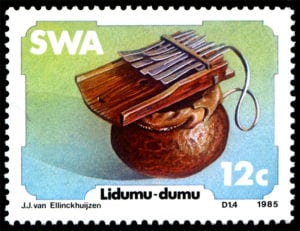
Credit: Namibia Stamps and Stories, Gondwana Collection
History
Lamellophones are a family of musical instruments consisting of a set of stiff but flexible tongues (lamellae) of varying length. They’re attached at one end to a soundboard that often has a box or calabash resonator.
Evidence shows they originated about 3,000 years ago in the area known today as Cameroon. The instruments then spread in different directions by human migration, becoming popular in southeastern Africa.
Within Namibia the instrument became known as a okashandja, kañombyo, ndingo, or otjisandji. Because the names are so local, there is a tendency outside of Africa to refer to any African lamellophone as a mbira or a kalimba.
Popularly referred to as thumb pianos, they arrived in Namibia around the sixteenth century when the AaWambo migrated to their present territory.
Construction
Early models were made of cane and raffia. In the first millennium CE (AD), people in what is now Zimbabwe introduced iron lamellae, or keys. With the refinement of iron technology, they continued to evolve.
While there are regional differences, all instruments consist of a flat wooden sound table, usually rectangular, carved from wild teak. They can be adorned with carved patterns, have small side edges, or be pierced with small holes to create a resonating chamber.
Iron strips beaten flat at the playing end, form the lamellae. Iron strips or wires fasten the ends to two raised edges of wood on one end of the sound table. They can be arranged in one or two layers and embellished with wires or metal rings to customize the sound and add buzz.
Tuning is usually done by a blacksmith who beats the laying end of the lamellae flatter or fixes a small blob of beeswax underneath them.
Lamellophones, Music, and Politics
Thumb pianos are held with both hands and played by plucking downwards on the lamellae with the thumbs. The movement produces a gentle, delicate sound.
According to tradition, Namibian lamellophones are only played by men.
There are over 100 kinds of traditional African lamellophones, each with its own tuning, note layout, and name.
The mbira, one of the most advanced types of traditional instrument, is played inside a gourd to amplify the sound and add a buzz.
The mbira dzavadzimu (mbira of the ancestors) is a lamellophone of the Zezuru Shona people of Zimbabwe. It’s the most widely known form of the Zimbabwean instrument. It’s closely associated with traditional spirit possession ceremonies. Its rise to prominence is often associated with the surge in nationalism that led to the Zimbabwean independence struggle of the 1970s.

